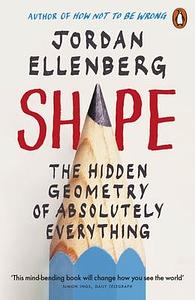Take a photo of a barcode or cover
Interesting, easy to follow, and very current and relevant. I most enjoyed the sections about disease spread and gerrymandering. I’d be interested to read more from the same author on other topics if he released them!
This was the most fun math book I have read! My new favorite! I love math so much!
funny
informative
medium-paced
Love his voice & humor. (Wisconsin would be all GOP without Madison & Milwaukee - if my grandmother had wheels, she’d be a wagon!) The chapter on holes in pants was probably my favorite since it took a math meme and did actual math, with plenty of guidance in how to do the math on your own. Didn’t care for all the eigensequence stuff, but overall it had a really nice balance of abstract + applied concepts.
This was just all over the place for me. At times, it was a two star read and somewhat boring (quite possibly because I know most of the math Ellenberg is describing); at times, it was a wonderful application of mathematical principles.
Here are my highlights:
1) The sections on gerrymandering are excellent. I learned a lot, and Ellenberg did a fantastic job explaining why proportional representation wasn't the ideal metric for dividing up districts and why random walks through the space of possible congressional districts can be a powerful tool.
2) Ellenberg likes to focus on the literary history of his mathematical interests, so we get a number of mathematician/poets. (Usually, they are better at mathematics.) And, in general, he explains well the cultural milieu of the times. I'm somewhat surprised that I first learned that Tolstoy was excommunicated in a popular mathematics book.
3) Bonus points for effectively using the illustrations from [b:A Wrinkle in Time|33574273|A Wrinkle in Time (Time Quintet, #1)|Madeleine L'Engle|https://i.gr-assets.com/images/S/compressed.photo.goodreads.com/books/1507963312l/33574273._SX50_.jpg|948387] to illustrate different metrics.
The problems:
1) Ellenberg can ramble; there are a few times I felt the book was turning into a primer on COVID-19 modelling (which isn't bad, but didn't feel like the book I started reading). At times, the emphasis on geometry works (especially when discussing huge multi-dimensional spaces), but sometimes I felt he was pushing too hard to make something geometrical (e.g., the SIR model for epidemics). Overall, the theme is there to give Ellenberg a focus, but it's not carried out strongly.
2) I'm never a fan of reading computations, and that happens a bit too often here.
3) I was sometimes jealous of how well Ellenberg described some ideas. (Yes, that's a problem I am ascribing to the book that really applies to me.)
If you are interested in a popular math book and willing to explore very different ideas of space and geometry than what you saw in high school, this can be a good read. For those with lots of mathematical background, it might be just okay.
Here are my highlights:
1) The sections on gerrymandering are excellent. I learned a lot, and Ellenberg did a fantastic job explaining why proportional representation wasn't the ideal metric for dividing up districts and why random walks through the space of possible congressional districts can be a powerful tool.
2) Ellenberg likes to focus on the literary history of his mathematical interests, so we get a number of mathematician/poets. (Usually, they are better at mathematics.) And, in general, he explains well the cultural milieu of the times. I'm somewhat surprised that I first learned that Tolstoy was excommunicated in a popular mathematics book.
3) Bonus points for effectively using the illustrations from [b:A Wrinkle in Time|33574273|A Wrinkle in Time (Time Quintet, #1)|Madeleine L'Engle|https://i.gr-assets.com/images/S/compressed.photo.goodreads.com/books/1507963312l/33574273._SX50_.jpg|948387] to illustrate different metrics.
The problems:
1) Ellenberg can ramble; there are a few times I felt the book was turning into a primer on COVID-19 modelling (which isn't bad, but didn't feel like the book I started reading). At times, the emphasis on geometry works (especially when discussing huge multi-dimensional spaces), but sometimes I felt he was pushing too hard to make something geometrical (e.g., the SIR model for epidemics). Overall, the theme is there to give Ellenberg a focus, but it's not carried out strongly.
2) I'm never a fan of reading computations, and that happens a bit too often here.
3) I was sometimes jealous of how well Ellenberg described some ideas. (Yes, that's a problem I am ascribing to the book that really applies to me.)
If you are interested in a popular math book and willing to explore very different ideas of space and geometry than what you saw in high school, this can be a good read. For those with lots of mathematical background, it might be just okay.
informative
medium-paced
hopeful
informative
inspiring
fast-paced
informative
slow-paced
challenging
informative
lighthearted
medium-paced
informative
medium-paced
challenging
emotional
informative
reflective
tense
medium-paced

